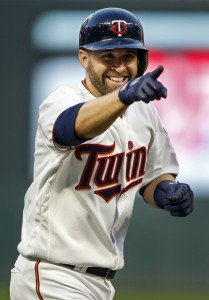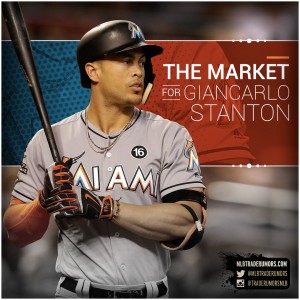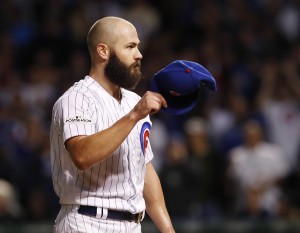During the offseason, rumors about major league players dominate the headlines. Fans and analysts alike discuss potential landing spots for major league free agents and trade candidates. With so much of the focus on big name MLB players, the subject of which top prospects could change hands falls into the background.
The players below are some of the most valuable trade assets in the game who have not yet lost their rookie eligibility. MLB Pipeline considers each of them to be among the top 25 prospects in baseball. They all play for teams that are firmly in “win now mode”. Indeed, all five of them belong to teams that finished with a top four record in baseball last season. It’s safe to say that, were they to dangle their respective prospects as trade bait, each of those teams could fill nearly any need on their big league roster.
Victor Robles, OF (No. 2 Overall Prospect): Nationals
The Nationals signed Victor Robles out of the Dominican Republic at age 16, and he’s met little resistance throughout his development. The Nats promoted him to the majors for the first time in September of 2017; he even made the club’s NLDS roster. In his 24 regular season at-bats, Robles managed six hits, including three for extra bases. The Nationals are in need of another starting pitcher, and the 20-year-old outfielder could easily bring back an elite arm. Washington’s outfield picture for 2018 seems reasonably clear, with Adam Eaton, Michael Taylor and Bryce Harper all under contract and Brian Goodwin as a solid fourth outfielder option. However, Robles is practically major league-ready right now, so it might not make much sense to trade him when he could easily contribute this season. eIt’s especially important to note that Eaton, Taylor and Harper all dealt with injuries last season. With that in mind, the Nationals might prefer to deal their second-best prospect, outfielder Juan Soto, instead.
Kyle Tucker, OF (No. 7 Overall Prospect): Astros
Houston took Tucker out of H.B. Plant High School in Tampa, FL with the fifth pick in the 2015 draft. The young outfielder proceeded to rocket through the club’s minor-league system, reaching the Double-A level midway through 2017. Tucker’s hit tool is one of the best among minor-leaguers, but the Astros already have other left-handed outfield options at the major league level. Josh Reddick and Derek Fisher both bat primarily from the left side, while George Springer, Marwin Gonzalez and Jake Marisnick figure to be ahead of Tucker on the depth chart heading into 2018 as well. That’s not to say that Tucker isn’t more talented than those players, but it seems like a lot would have to happen for him to stumble into significant playing time next season. On the other hand, the Astros don’t have a clear hole on the major league roster outside of the bullpen, and Tucker is far too valuable to trade for a reliever. The organization has also reportedly been stingy about trading any of their top prospects lately, so perhaps it’s unlikely we’ll see him moved.
Francisco Mejia, C (No. 13 Overall Prospect): Indians
Mejia’s development has been a somewhat slow process; the Indians signed him out of the Dominican Republic all the way back in 2012. However, he’s vaulted up prospect lists after incredible success across the past two seasons, including a 50-game hit streak during the 2016 campaign. The best catching prospect in baseball is only 21 and has an elite hit tool from both sides of the plate. Cleveland decided to give him a bit of seasoning at the major league level this past September, which seems to imply that they think he could be close to MLB-ready. The Indians already have catchers Yan Gomes and Roberto Perez under contract for the foreseeable future, so Mejia could be a good candidate to be exchanged for help at first base if Carlos Santana signs elsewhere. But the Indians are also testing Mejia out at third base in the Arizona Fall League, a position he could more easily claim on the Tribe’s roster at some point in 2018.
Triston McKenzie, RHP (No. 20 Overall Prospect): Indians
After McKenzie struck out 157 batters in 91 innings during his senior year in high school, Cleveland selected the right-hander in Competitive Balance Round A of the 2015 draft. The lanky 20-year-old stands at 6’5″ and throws his fastball in the low 90s, though most scouts believe he could pick up even more velocity as he grows stronger. McKenzie struck out double-digit batters in six different games at the High-A level in 2017, including a 14-strikeout effort on May 9th. Overall, the Royal Palm Beach High School product pitched to a 3.45 ERA (and a 2.67 FIP) while punching out 11.71 batters per nine innings. With the Tribe’s window of contention seemingly at its peak, and McKenzie highly unlikely to reach the majors in 2018, the righty could potentially end up being an excellent trade chip. Even if the young righty were MLB-ready, the Indians already have a stacked rotation that will include Corey Kluber, Carlos Carrasco, Trevor Bauer and two of Danny Salazar, Josh Tomlin and Mike Clevinger. McKenzie could be dangled for help at first base (should Santana depart), or elite bullpen help such as Brad Hand or Felipe Rivero.
Alex Verdugo, OF (No. 23 Overall Prospect): Dodgers
The Dodgers took Verdugo in the second round of the 2014 draft, and the left-handed outfielder has done well at every level of the minors. His power isn’t prolific and his speed is average, but his hit tool is excellent. Verdugo is patient at the plate and is great at hitting to the opposite field. While fellow Dodgers prospect Walker Buehler is excluded from this list due to his proximity to the majors and a fairly clear opening in LA’s rotation, Verdugo could be more of a luxury than a vital asset. Chris Taylor and Yasiel Puig are set to man center field and right field, respectively, and it’s unclear whether the Dodgers are ready or willing to give up on Joc Pederson yet, especially following a strong postseason performance. Verdugo could potentially be used to land a strong second baseman. It’s not outside the realm of possibility that he could be used to acquire a more proven outfielder, either. Still, the Dodgers have four other top 100 prospects outside of Buehler and Verdugo. Even if they attempt to make a blockbuster trade during the offseason, they might prefer to move someone a bit further away from the majors.
What do you think? Which of these top 25 prospects is most likely to be with another organization by the time spring training rolls around? (Poll link for app users)




